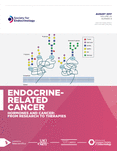Metabolic profiling of cholesterol and sex steroid hormones to monitor urological diseases
- 1Molecular Recognition Research Center, Korea Institute of Science and Technology, Seoul, Korea
- 2Departments of Surgery and Biomedical Sciences, Cedars-Sinai Medical Center, Los Angeles, California, USA
- 3Department of Medicine, University of California, Los Angeles, California, USA
- Correspondence should be addressed to M H Choi or J Kim; Email: mh_choi{at}kist.re.kr or Jayoung.Kim{at}cshs.org
Abstract
Cholesterol and sex steroid hormones including androgens and estrogens play a critical role in the development and progression of urological diseases such as prostate cancer. This disease remains the most commonly diagnosed malignant tumor in men and is the leading cause of death from different cancers. Attempts to understand the role of cholesterol and steroid metabolism in urological diseases have been ongoing for many years, but despite this, our mechanistic and translational understanding remains elusive. In order to further evaluate the problem, we have taken an interest in metabolomics; a discipline dedicated to the systematic study of biologically active metabolites in cells, tissues, hair and biofluids. Recently, we provided evidence that a quantitative measurement of cholesterol and sex steroid metabolites can be successfully achieved using hair of human and mouse models. The overall goal of this short review article is to introduce current metabolomic technologies for the quantitative biomarker assay development and also to provide new insight into understanding the underlying mechanisms that trigger the pathological condition. Furthermore, this review will place a particular emphasis on how to prepare biospecimens (e.g., hair fiber), quantify molecular profiles and assess their clinical significance in various urological diseases.
- Received 29 July 2016
- Accepted 4 August 2016
- Made available online as an Accepted Preprint 31 August 2016
- © 2016 Society for Endocrinology
 This work is licensed under a Creative Commons Attribution 3.0 Unported License.
This work is licensed under a Creative Commons Attribution 3.0 Unported License.












